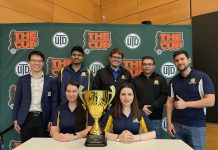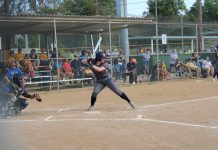Click here to view this week’s online print edition of The Journal to view a map on page 8 of where Webster players competed this summer and some of their statistics.
Even after the final out of the College World Series, the Webster University baseball team’s season wasn’t completely over.
Each year, coach Bill Kurich has his healthy players compete in summer baseball leagues around the country and beyond.
“That is something I’ve been doing since I started coaching, something we installed immediately right when we (the coaching staff) got here at Webster,” Kurich said.

Having his team play throughout the summer isn’t anything new for Kurich. He started the tradition at previous schools he coached at, such as Concordia University (Ill.) and St. Joseph’s College (Ind.).
“It’s just the more our guys can play and play with good competition, the better they come back to us in the fall,” Kurich said. “That’s something we talk about during the recruiting visit. We make sure they know we expect our guys to play in the summer and get them some opportunities to go to different places if their family situation allows it. There are a lot of guys that go back and play at leagues in their home so they can work and what not.”
The baseball team had 14 of its healthy and returning players compete in 10 different leagues this summer. The leagues were as far from Webster as Idaho, Florida and even Canada. Some elected to stay closer to home and play in St. Louis or the Chicago area.
The decision to play in a particular league comes down to several factors, such as location and what connections Webster’s coaches have. Junior catcher Matt Mason had it narrowed down to three choices — stay in St. Louis, which would have been closer to home for the St. Charles native, or head to Arizona or Boise.

“The only thing I knew about (Boise) was that it’s home to Boise State,” Mason said. “I don’t have any family out there or anything. The thought process for me was that during my freshman year I played in a St. Louis league — I didn’t really like it. I thought it was a waste of money and time, and I didn’t really think it benefited me as a player.
“It came down to me going to Boise or Arizona, and the reason why I chose Boise was that Boise is an instructional league. So not only do you play games, but there are clinics every day.”
Mason played in the Boise Summer League located at Northwest Nazarene University, a Division-II school. That league is one of several options for Gorlok players. Kurich said there are a number of leagues funded by Major League Baseball, which Webster players can choose.
“We’ve had a number of players go out and it doesn’t cost them anything. They’re set up with a host family and there is no fee to play in the league,” Kurich said. “Some leagues charge anywhere from $400 to $1,500 for the summer. That generally includes their living expenses, their playing fee, those types of things.”
Mason had to pay his own way to Boise this summer.
“We do fundraise as a team for team things, but the team’s money cannot pay for us to go play,” Mason said. “We have to pay our own way to go. I work two jobs during school, so I work to pay for most of my own stuff. My parents kind of helped me out, sort of as a reward for working hard and getting good grades.”
Gorloks travel together
Two returning seniors, pitcher Steven Dooley and center fielder Cody Stevenson, headed to the Big Apple this summer to showcase and improve their talents in the New York Collegiate Baseball League. Sophomore pitcher Isaac Behme also played in the league.
“Coach Kurich is really good about setting all his players up with a team and a league that he feels is a good suit for them,” Dooley said.
Stevenson and Dooley played for the Hornell Dodgers, and both played in the All-Star game for the league’s West team. Stevenson said having a fellow Webster athlete on the team with him helped him relax.
“If he’s pitching and has a rough inning, I can come in to the dugout and we can talk and joke around and get our mindset right,” Stevenson said. “If I’m having a bad game, he does the same for me. It’s comforting to have that guy there you know and have played ball with so you know how to handle things.”
Mason said the pitchers he faced seemed a bit familiar. He contrasted the hurlers in the Boise league to recently graduated Webster pitcher David Mueller.
“The best way I can explain it is that every team had a David Mueller,” Mason said. “David was our best pitcher last year, and every team in this league had a guy who was similar to Dave in pitching ability and what they brought to the table. Some teams had maybe even two Daves.”
Mason and junior infielder Michael Aaron, Mason’s roommate since his freshman year at Webster, made the trek to Boise, but the two played for different teams. Mason played for the Bear Valley Rapids, while Aaron suited up for the Pepsi Wolfpack.
“We’ve become best friends,” Mason said. “In the selection process, (Aaron) had a few more choices than I did. We thought it would be cool to go together. It made it nice, because anytime you go 1,800 miles away from home, a 24-hour drive, it makes it easier knowing somebody and having a friend there.”

A chance to improve for spring season
Playing baseball during the summer isn’t just a way to keep Webster players from becoming rusty — it’s also a chance to get better for next season.
Stevenson collided with the center-field wall in the eighth inning of Webster’s final World Series game in Appleton, Wis., on May 28. He was carted off the field and diagnosed with a stinger in his neck and a concussion. The NYCBL’s season started, and Stevenson had to stay behind until he passed the baseline test, which is given to Webster athletes at the beginning of each season.
Once he passed, Stevenson chomped at the bit to get back to center field.
“Being held back like that, it was almost like I got that feeling that I wasn’t able to play,” Stevenson said. “As soon as I got up here, I was ready to jump back in it. The coach up here was obviously questioning me with, ‘Are you OK to play? Do I need to sit you out a couple of games and get your feet wet again?’ I said, ‘No, throw me in with the wolves. I’m ready to go.’”
Stevenson wanted to spend this summer working on his swing in particular. Though he ended 2012 with a .289 average and 59 stolen bases, the center fielder went 12 for 52 in the postseason.
With the Gorloks graduating two senior catchers, Mason will be fighting to become the everyday catcher or at least earn a bigger role for 2013.
“(Kurich) told me the things I need to work on, things holding me back from being the guy,” Mason said. “… I want to be able to have a role on the team next year as opposed to a guy who comes off the bench every now and then. This summer allowed me to work on my defensive skills … that’s going to prepare me for next season.
“Whatever my role is — whether I’m lucky enough to be the starter or backup guy — having played 24 games against good competition is going to make that transition into spring easier.”
Dooley, who went 6-5 with a 3.62 ERA and earned seven saves in 2012, worked on adding a slider to his pitch repertoire for the spring.
No matter what each Gorlok works on, Kurich said the summer helps his players hone their skills in a more relaxed environment.
“The first and foremost thing is for our guys to go out and have fun playing baseball,” Kurich said. “… I find that our guys come back a little more mature, stronger.
“I think the results individually have been great … you see kids grow up a lot. And it’s a great experience, the opportunity for a young man to go out and see a different part of the country. I’d trade places with them right now. That’s as good as it gets.”
— Josh Sellmeyer contributed to this report.



